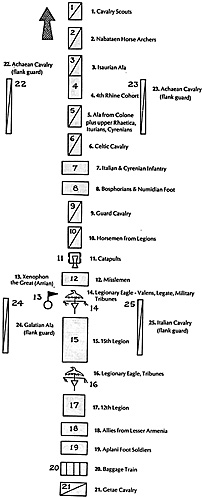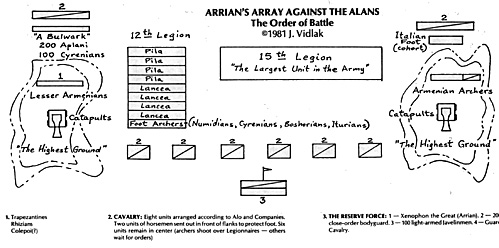Arrian was the Roman Governor of Cappadocia during the reign of Hadrian, (2nd Century AD). Arrian, who calls himself Xenophon the Great, wrote his 'Array' describing his tactics against the Alans. The Alans, which Arrian often calls Scythians, were a Sarmatian tribe and relied heavily on shock cavalry. Arrian's 'Array' discusses a Roman army on the march, and his placement of units and tactical plan to defeat the charging Alan horsemen.
While this is a 'historical' article, I it is a fine piece of tactical
strategy. It had remained unavailable to the general public
until recently when Jim Vidlak translated it into English.
Arran's Array is very useful for the Ancients buff. It shows the
tactics the romans would employ to stop shock cavalry. The
placement of their missile troops is especially interesting. The
horse archers are behind the Legions, shooting overhead,
and is a source reference to 'indirect fire'. This article should
give the battlefield tacticians and the rules writers among you
something to consider.
 THE ORDER OF MARCH
THE ORDER OF MARCH
The cavalry scouts are to take the lead of the entire field army, formed in a column of twos in company with their local chieftan. And after them, the Nabataean horse archers, also by two. And leading them are the clecurions. Now following them is the Isaurian ala, together with the fourth Rhine cohort, whose leader is Daphne of Corinth. Next comes the ala from Colone, together with those from Upper Rhaetica, and the Iturians and Cyrenians. Demetrius commands the entire unit. Now after these comes the Celtic cavalry, also in a column of twos, a centurion commanding them just like he would command a cohort of foot soldiers. Next, the Italian and Cyrenian infantry are arrayed (those who are present), keeping their standard in front of them. Poulcher leads both units just as he commands the Italians. Next comes the Bosphorian foot and then the Numidians. Lamproclea is the proven leader of the former, while Bero leads the latter. Now the formation of those on foot is a column the width of four close-order infantry, with all of the archers placed in front. The Achaean cavalry guards the flanks of the column.
Following the Numidians comes the guard cavalry and then the horsemen from the legion. Next comes the catapults, followed by the eagle of the Fifteenth Legion, together with Valens the legionary commander, the legate and military tribunes (Valens, himself, appointed them) and the centurions who command the first cohort. And the missilemen are placed in front of the eagle. The legionaires are to march in a column of fours. And after the 15th Legion comes the eagle of the Twelfth Legion, together with the military tribunes and the centurions. The legion should be arranged by fours just like the 15th Legion.
Now after the legions come the allies from Lesser Armenia, the close-order Trapenzantians and Colchoi, and the javelin-armed Rhiziani. The Aplani foot-soldiers follow them. And Sekoulinus leads all of the allies, just as he leads the Aplani. The baggage train follows the allies. Finally, the Getae cavalry, with their own leader, bring up the rear. And let the centurions who have arrayed the legions command at the sides of the legionaires. Now concerning the guard; the Galatian ala formed in single file rides along one side of the formation, the Italian cavalry do likewise on the opposite side. And the cavalry leader goes to and fro by the side of the guard.
Now Xenophon the Great, the leader of the entire army, commands in front of the legionary eagles. He also rides past the entire array and inspects the formation in order to maintain order. Now those whom he finds in disorder he returns into proper array and those who maintain proper order, he praises. This is how the army remains in an orderly fashion on the march.
THE BATTLE ARRAY
Now after reaching the selected place of battle, all of the cavalry form a perimeter in square formation. The cavalry scouts are sent to occupy the high ground as a lookout because of the enemy. And when the scouts signal the enemy approach, the army takes up their arms in silence and stands ready in battle array. Now this is the order of battle. Each wing of the foot soldiers guards the higher ground, because the entire battle array is formed between the wings.
On the right wing the Armenians are formed around Vasace and Arbela, guarding the highest ground of the flank. In this way the archers are concentrated in one spot. And the foot soldiers from the Italian cohort are placed in front of the archers. Poulcher, the leader of the Italian band, commands all of them, the Armenians, both horse and foot, placi'ng themselves under his direction. And upon the left wing they form also, occupying the highest ground of the flank, so that those from Lesser Armenia, both the light-armed Trapenzantines and the javelin-armed Rhiziani, may fight together.
And the two hundred Aplani and the one hundred Cyrenians are formed in close-order as a bulwark in front of the javelinmen and the archers who shoot overhead out of the high ground. And between the two flanks, the legionaires from the Fifteenth Legion occupytheentire right,extending through the middle of the battlefield, because they are an extremely large number, the largest in the army. And the legionaires of the Twelfth Legion are at the end of the left side' completing the remaining ground between the flanks. They are formed in eight ranks and are a single, dense formation.
Now the first four ranks are armed with shafted weapons. These weapons consist of a long and somewhat light iron point attached securely to the front of the shaft. The front ranks keep their weapon leveled as the enemy draws near to them. The iron points of the shaft are placed specifically at height of the breast of the horses. And those in support, even both the third and fourth ranks, throw the weapon forward for the purpose of piercing the rider. Wherever the thrown weapon may hit, the horses shall scatter (truly understanding the nature of horses); the rider shall be rendered useless both from the impacting of theshaft in shield, horsemail, breastplate and from the iron point having previously been bent because of its softness.
Now the next four ranks are armed with the lancea. And behind these, the ninth rank consists of foot archers; the Numidians, Cyrenians, Bosphorians and Iturians. And the war engines are placed near the flank on either side at a far distance from the enemy army, in order that they may shoot overhead from behind the formation.
The cavalry is recalled and formed together into eight units according to alae and companies. Two companies are sent out one to each of the flanks, to guard the close-order infantry in front of them and the archers on the high ground. The remaining six companies are posted in the middle of the legionary array. All of the horse archers from these six companies are posted immediately behind the legions, so that they may shoot overhead beyond them.
All those cavalry who carry the javelin, the lance, the sword or the axe are formed into files behind the array and are to await specificorders. Nowthe guard cavalry isformed with Xenophon, together with as many as two hundred legionaires (thosewhoform his bodyguard), and all thecenturions of the bodyguard, the leaders of the bodyguard and the chosen clecurions, togetherwith one hundred light-armed Javelinmen. The entire reserve force travels from one end of the formation to the other, observing carefully and providing assistance where needed. Now Valens, the commander of the Fifteenth Legion, controls the entire right flank, including the cavalry; the tribunes of the Twelfth Legion, the left flank.
THE TACTICAL PLAN
Thus the army is formed. Let it stand in silence, so that the right flank may raise a great and fearful war cry when the enemy is advancing within missile range. At this time missiles and stones are discharged from the war engines, the psiloi and leviesclischarge both arrowsfrom thearchers andjavelinsfrom thejavelinmen, and large stones from the catapults are carried into the enemy out of the high ground. All Ballistae fire together, not for the purpose of making the greater part of the charging Scythians inferior to the 15th Legion, butwith one extremely dense fire, both to frighten the horses and to ruin the enemy cavalry, causing them to lose hope under this indescribable mass of projectiles.
And if the Scythians continue to advance, the legions close ranks, being shield to back and shoulder to shoulder, in order to receive the assault in the strongest possible formation. And the first three ranks, in a compact locking of shields, are as fierce as possible when meeting the enemy impact. Now the fourth rank casts their lancea overhead, and the third rank either jabs out with the pila or throws it overhead without restraint, aiming at both horse and rider.
Now once the enemy is repulsed (assuming a decisive rout occurs), the cavalry must interpenetrate the foot soldiers in order to pursue the broken enemy. Those who were initially formed behind the legions are first to give chase. However, only one-half of the companies are to engage in pursuing, but in formation and not involving themselves with the chase, so that if strong ones may hold fast in flight, the first pursuit should wait for the fresh cavalry.
And if they should overtake those who are returning to battle, they should attack them. And the Armenian archers should advance, shooting their bows at the enemy, so that they do not have a chance to rally. And the light-armed javelinmen should set upon them at full speed. Even the legionary formation is to remain no longer in position, but are to advance swiftly or at the quick-march, so that should anyone meet very strong resistance from the enemy, the infantry may be cast forward again in front of the cavalry.
Now the following of which I do not approve (never!), might just happen. If from the first assault a rout may occur in the opposite direction, and if the enemy desires to overtake the wings, wheeling about in a circle upon them, the psiloi archers should spread themselves out upon the high ground, extending the flanks. The enemy, seeing that the wings have been made weak by extending the psiloi to cover more ground, may force themselves and cut through the foot soldiers, and hence, overrun one flank or the other.
At this time it is essential that the cavalry maneuver to the flanks of the enemy and that they charge into them, not discharging their javelins, but giving battle with the sword and with the axe. And the Scythians, rider and horse being exposed, keeping .... (end of fragment - Editor).

Back to Table of Contents -- Courier Vol. V #3
To Courier List of Issues
To MagWeb Master Magazine List
© Copyright 1984 by The Courier Publishing Company.
This article appears in MagWeb (Magazine Web) on the Internet World Wide Web.
Other military history articles and gaming articles are available at http://www.magweb.com